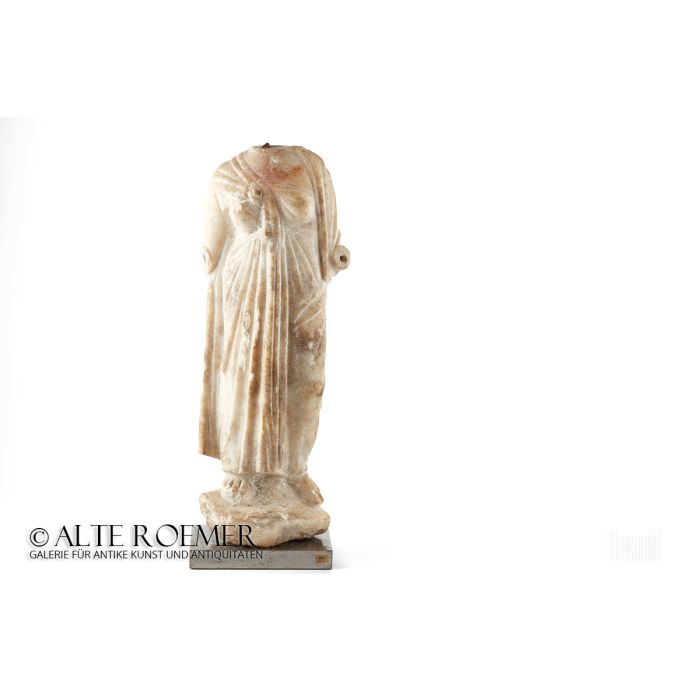Roman marble Isis statue - ex Christie's New York
Price: on request
Sold
Object number
AR2974
| Object: |
Statue of Isis
|
| Material: |
White marble
|
| Date: |
About 1st - 2nd century A.D. Roman Empire |
| Description: |
The mantle knotted over her breast clearly identifies the statue as depiction of the goddess Isis (so called "not of Isis"). The goddess is standing straight, with her light knee very slightly bent and the torso correspondingly slightly inclined to the right. In her arms, she originally most probably held the Sistrum (rattle) and Situla (pail) used in the rites of her cult. The mystery cult of Isis became popular in Rome probably already in the 2nd, but certainly in the 1st century B.C., when Sulla built a temple of Isis on the Capitoline Hill in Rome around 80 B.C. The cult was more (e.g., under Caligula or Hadrian) or less (e.g., under Augustus or Tiberius) popular during the entire Imperial era and also during Late Antiquity. It was not before the 6th century A.D. that the main Isis temple was closed by Emperor Justinian. |
| Size: |
Height 42.9 cm with and 41 cm without base
|
| Condition: |
Surface nicely preserved. Head and forearms were attached separately, now missing. Broken edges at base indicate that the statue was originally part of a larger group. Mounted on a modern metal base. Old illegible sticker on base.
|
| References: |
Compare the marble Isis statuette at British Museum, London, with Museum number 1861,1127.84 For the knot of Isis, see T.T. Tanh, in: Lexicon Iconographicum Mythologiae Classicae (Zürich und München 1990), s.v. Isis Nr. 32, p. 766, who also gives further references and examples |
| Provenance: |
Acquired 2017 in an auction house. Ex private collection of the French engineer Mr. E., acquired June 11, 1975, at Galerie Carrefour, Pierre Vérité, Paris, France. The originale expertise from P. Vérité is preserved. With French export permit Nr. 185517 from July 21, 2017. Ex. Christie's New York City Auction 18865 (October 2020). |
| Certificate: |
An Art Loss certificate is available for this object (see pictures). The Art Loss database comprises over 500.000 ancient objects which were reported as lost or stolen and also actively involves the corresponding Interpol and FBI databases. A print copy of the Art Loss certificate will of course be delivered together with this object.
|
| Authenticity: |
We unconditionally guarantee the authenticity of every artefact, all items are subject to our lifetime return policy on authenticity.
|


